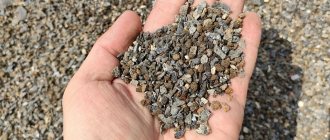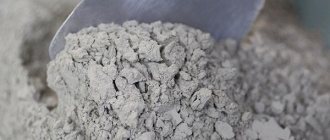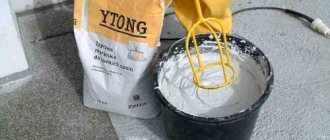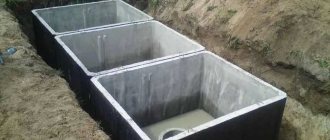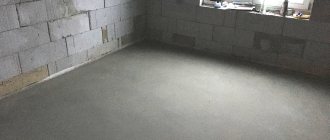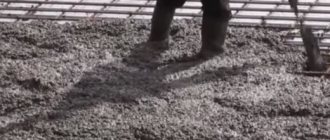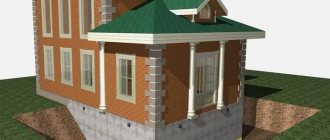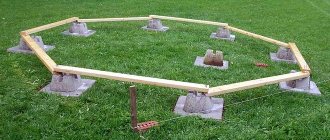Crushed stone screening is a by-product of production obtained by crushing various rocks.
Due to the fact that during the production of crushed stone, in accordance with GOST, which regulates its production, the processed material is divided into different fractions, the smaller of which is from 5.0 mm, then after sifting, the processed material is included in the screening composition, with a fraction from 0 ,1 to 5.0 mm. Depending on the source raw material, crushed stone screening can be: granite (bulk density 1320 - 1340 kg/m3), gravel (bulk density 1400 kg/m3) and limestone (bulk density 1300 kg/m3).
Crushed stone screening
This material is secondary, and is obtained after crushing various rocks.
Crushed stone screening is classified depending on the original raw material and comes in several types:
The fraction of granite screenings is obtained as a result of crushing natural stone. It is similar in appearance to sand, but does not contain clay and other impurities. It is frost-resistant and environmentally friendly. Often used to decorate flower beds.
Gravel - formed from inorganic rocks. It is a loose residual material containing mineral particles, which makes it less durable.
Limestone – has a grain size of up to 5 mm. It has astringent properties and is also soluble in water. This material is often used in winter during icy conditions to pave the road.
What kind of paint is added to paving slabs?
To paint the surface of a tile covering, several types of dyes for paving slabs are used, in particular, alkyd and polyurethane paints. During intensive use, it is necessary to periodically renew the color layer.
Interesting materials:
What do tour operators do? What did the collegiums do under Peter 1? What did the Varnas do? What did the strategist do? How to protect the board from moisture? How to darken areas on the face? What can you teach a budgie? What is 1 teaspoon of dry yeast? What is the standard enthalpy of formation of a simple substance? Whose Caribbean Islands?
Material characteristics
Crushed stone screening has certain characteristics that determine its scope of application:
- resistance to mechanical loads;
- size;
- embankment density;
- high frost resistance;
- various shapes of grains - needle-shaped and flat;
- amount of various impurities.
If you search on the Internet “how much does screening cost,” you will notice that this material is budget-friendly and allows you to reduce overall costs during construction or other work.
The concept of specific gravity, its calculated parameters
Specific gravity is defined as the ratio of the mass of the raw material to its volume. Depends on the size of the fractions and the density of screenings. A description of the material is contained in the manufacturer's accompanying documents.
Flakiness (needle-like, plate-like particles) is important when determining weight. The severity of the material depends on the level of the grain plane. The cubic structure of the stone is the optimal shape for sowing.
Calculations are needed when purchasing material. Knowing the parameters will help determine the volume of goods. When ordering, use a correction factor that is equal to 1.1 (10% reserve).
The table shows the dependence of weight on fraction size.
| Fraction size (mm) | Weight (t/1 cubic meter) |
| 0,1-4,8 | 1,41 |
| 4,9-5 | 1,33 |
Smaller grains are heavier in weight than larger fractions for the same unit of volume.
The main area of application of crushed stone screening
Many people think that the use of dropouts is most common in landscape design, but they are wrong. A large consumption of screenings occurs in asphalt laying. Screenings are an important material in the production of high-quality concrete for asphalt, as it provides it with high strength. Here the screening serves as sand.
Screening is widely used in landscape design. There are many paths and areas on the street, which are lined with screenings. It mainly has the appearance of pink granite. Designers have come up with many ways to use this material in their field.
In addition to design, screenings are often used in the production of mortars. To obtain these solutions, sand is mixed together with screenings. Thus, significantly increasing the strength of the product. For example, sidewalks and curbs are laid from this mixture.
And last on the list are utilities. They use screening as a means of ice control.
If we talk about individual construction, screening is also used here. For example, in casting a foundation or designing a landscape design. This is not the entire liver where screening can be applied.
It may come as a surprise to many, but screenings are actively used for fertilizer in agriculture.
Using Sand Screening
Sand screenings are pieces of rock that remain after washing the main sand mass. This material is not used in cement concrete mixtures.
Screenings are a waste material in the production of crushed stone, so their cost is several times less. Therefore, many people want to use just such a mixture.
But the use of such material is only possible for structures with low loads. And then, only a small part of the main crushed stone can be replaced.
How to make a solution from screenings?
To create a high-quality solution from screenings, cement and water must be of high quality so that the finished material is durable. It also depends on the correct proportions.
It is best to search the Internet for “how many dropouts do you need” so as not to make a mistake. List of necessary materials and tools for making the solution:
- cement;
- dropout;
- water;
- mixing tool (concrete mixer).
Sand is a popular building material, and this makes it quite expensive. Thanks to modern technologies, it has become possible to replace sand with conventional screening.
The quality characteristics will not deteriorate from this. That is why today many manufacturers prefer crushed stone screening and actively use it for various purposes.
Preparation of concrete
You can make the solution yourself. The best way to do this is to use a concrete mixer. If this construction machine is not available, any container for preparing a future batch will do. To prepare concrete from screenings and cement, precise proportions must be observed in order to obtain the desired performance properties. Each component plays a significant role.
Figure 4. Preparation of concrete mixture
Proportions
The mixture is made taking into account many factors. Cement plays a significant role in mortar. To create a high-quality mixture, it is important to choose the appropriate brand of cement. Highly graded raw materials provide better adhesion of concrete to different surfaces.
It is important to observe the shelf life of cement, since, being unused, its performance properties are reduced. For example, after a month the strength decreases by 10%. There is a way to find out if the cement is suitable. To do this, scoop it into your palm and squeeze it. If the cement has a crumbly structure, then it will make a good solution. The marking of the material directly affects the price. But the higher the number next to the letter “M”, the better the performance of the cement.
The specific type of screening is chosen taking into account the level of loads that the coating will withstand. Temperature operating conditions are also important. The solution that was made from granite and cement will be cheaper. A more expensive option is mixing sand with crushed stone. An example where the task is to flood the yard. Here, an additional element is the reinforcing mesh. The thickness of the pouring layer is 7 cm. The granite-based mixture is prepared in the following proportion: cement M400 (1 part), screenings (8) and no more than 20% water. The prepared mass will have a strength of M150. Granite comes to the rescue if you need to pour a foundation. In the case of a yard, you will need a sand cushion. However, the latter easily replaces the screening itself, which is first compacted and then poured. The thickness here is required to be at least 5 cm.
Water
The proportions of water play a significant role. The final mass should have a medium consistency, and this is what they start from when determining the amount of water. If there is too much of it, the structure of the mixture will be disrupted and will shrink greatly during use. This not only reduces the load-bearing capacity of the material, but also often leads to the formation of cracks. Water quality is also important. When producing high-strength concrete, enterprises use drinking water rather than industrial water.
The proportions for a mixture without sand were described above. It is not necessary to eliminate it completely; it is enough to replace it partially. But you will have to add crushed stone. The proportions will look like this:
- cement M400 – 1 part;
- elimination – 1 – 2;
- crushed stone – 3;
- sand – 3;
- water – no more than 20%.
Important! At this ratio, the added screenings do not increase the final volume of the mixture. Its auxiliary role is reduced to binding sand with crushed stone.
According to construction newcomers, the more cement you add, the stronger the concrete. This is a misconception: excess cement will only reduce the quality of the material. The only thing that matters here is the brand.
Preparation of the solution
If you plan to produce a large volume of concrete, it is more convenient and faster to work with a mixer. Not only is doing the job by hand more difficult, it will also affect the final quality of the product. All prepared components in the correct ratio are poured into a concrete mixer or a special container. Then they are mixed until a homogeneous mass is formed. Only at the end, and then in small portions, is it necessary to introduce water. At this stage, constant stirring is required. The mass and moisture content must be uniform - only this solution is ready for use.
The prepared mass should be used within the next two hours from the moment of preparation. Further, its properties will begin to be lost. It happens that moisture evaporates during kneading. You are allowed to add as much of it as is necessary to achieve the desired consistency. Often the mixture is made using already wet components - this can cause a decrease in the amount of water.
Figure 5. Adding water to the mixture
Photo of dropouts
https://www.youtube.com/watch?v=-7olzB8L0Sk
